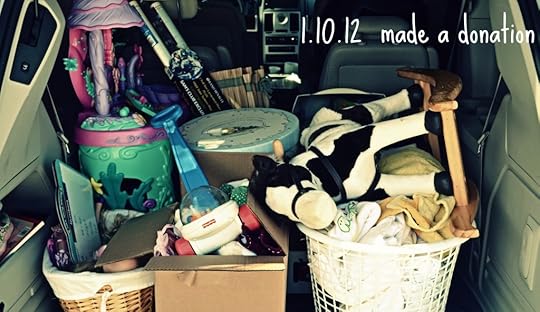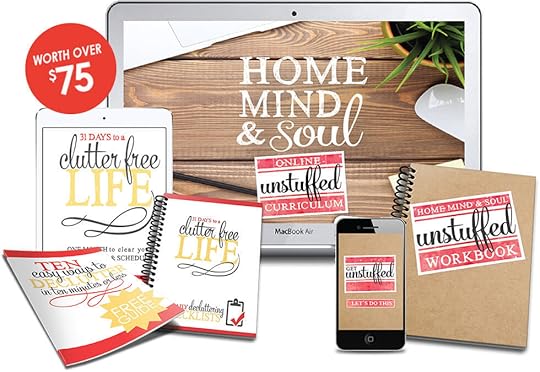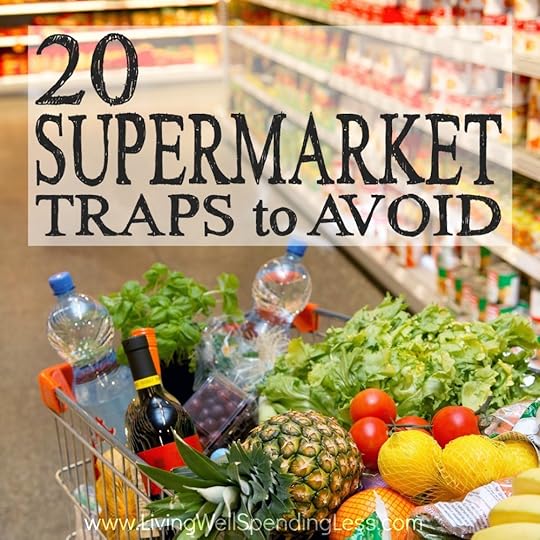Ruth Soukup's Blog, page 64
March 30, 2016
Why We Say NO to Gifts
Three years ago, in one fateful moment that would change our lives forever, I packed up all my kids’ toys and inadvertently kicked off a toy-free revolution.
The original blog post I wrote about the incident went viral online many times over, receiving millions of page views, hundreds of thousands of shares, and thousands of comments and letters, ranging from people who were inspired to do the same to those who feared I was causing lasting psychological damage to my poor deprived toyless children. Even today, the debate rages on.
For the most part, I have learned to tune it out.
Because, you see, while taking my kids’ toys away was certainly a turning point for our family, it was only one of many, many moments, both good and bad.
And while, in the years since, we have tried to be a lot more vigilant about keeping the pile of books and clothes and toys and games and keepsakes and papers to a minimum, my kids still have a LOT of stuff—far more than they need, and far more than I would like.
Because as every parent knows, with kids, the stuff just keeps coming.
Every birthday party invitation means another goodie bag full of cheap plastic garbage. A good day at school ends with a prize from the treasure box. The next-door neighbor drops off a box of toys their own kids are no longer playing with, or a sweet auntie sends a care package full of goodies just because. Every holiday brings its own pile—Christmas presents and Easter baskets and Valentine’s treats and birthday gifts. New clothes because the old ones wear out and become play clothes but still stick around. And then there’s the artwork and crafts and projects. And the papers. Oh, the papers.
It’s endless.
Or maybe it’s just my kids that have seemingly become a bottomless source of STUFF. In any case, the reality is that our completely toy-free environment—the one I wrote about in that viral blog post—was only temporary.
The stuff keeps coming back.
And what I often see as clutter, my daughters see as treasure, which means that we have to find a way to strike a balance between letting our kids hold on to things they truly love and appreciate, and preventing our home from becoming a clutter free-for-all.
I’m not sure we will ever get it exactly right, but over the years, we have stumbled upon a few helpful strategies that let us all keep our sanity in the midst of this battle. I cover all of these strategies in detail in my new book Unstuffed, but there is still one question that gets brought up by every parent I have ever talked to:
What do I do about gifts?
Quite frankly, it is a dilemma I can relate to all too well, as we’ve faced the prospect of well-meaning friends and relatives wanting to bestow their love for our kids in the form of more and more things, from toys to books to clothes and everything in between.
And I’ll be honest—it is a delicate tightrope to walk, this line between not wanting to hurt the ones we love and actually making effective headway in this battle against stuff, one that I certainly haven’t always walked well.
Learning the Hard Way
In fact, when I think about this battle, one particularly painful lesson comes to mind. You see, one Christmas, several years ago, my sister-in-law Linda came bearing so many gifts that it literally took us all day to open them.
At first, it was sort of sweet. We knew Linda adored our girls and this was her way of showing them how much she cared. Plus, it was her money. What was it to us if she wanted to spend it on our kids?
But as the empty boxes and bags of garbage piled up in the garage, we became more and more anxious about the situation. What were they going to do with all this stuff? How could they possibly play with it all? And where would we put it all in our three-bedroom, no-basement house?
I wish I could say we handled the situation gracefully. I wish I could say that at some appropriate moment we quietly pulled Linda aside and gently explained that while we were incredibly grateful for her generosity, we just felt like this was all far too much stuff for two little girls, and that we wanted them to be able to truly appreciate a few things, rather than be overwhelmed by such a large pile.
I also wish I could say that we told her that we knew she wanted what was best for them, and that we knew she would want them to grow up to be sweet, grateful girls, not bratty entitled ones, and that we were afraid that over time, so many gifts all the time would start to lose their meaning to them.
And I wish I could say that after we talked, she totally saw our point and agreed to stop going overboard, and that everything was completely perfect from there on out.
But none of that happened.
Instead, after Christmas Linda flew back home, and we were left to deal with the mess left behind. Our New Year’s resolution that year was to try to get a handle on this avalanche of stuff that was threatening to bury us alive, and so we began to sift and sort and selectively pick things to donate or sell. We figured that if Linda ever asked, we could just tell her some of the items were in the attic. It was a perfect plan, we decided, and Linda would never have to know.
It may very well have been a perfect plan, except for the fact that I am a blogger, and also sometimes a complete idiot. In my eagerness to share my organizing and decluttering progress with the world, I triumphantly took a picture of the back of our Tahoe filled to the brim with donation items, many of which were gifts from Linda.
Ouch. Talk about ruthlessly purging!
Even now, years later, I cringe thinking about how much that picture must have hurt her. Because yes, of course she saw it, and yes, of course she was incredibly upset and offended by it. As well she should have been. It was beyond harsh, and I know we could have avoided a lot of hurt feelings by just being honest from the get-go.
Even so, that photograph of our jam-packed Tahoe did serve one positive purpose. It finally opened up a very honest conversation about gifts, and about how we wanted to raise our kids. After apologizing profusely, we were able to explain that we wanted them to remember her for the time she spent with them, not for the pile of presents she brought with her when she visited. We set limits with Linda by clearly laying out our boundaries and expectations.
The change didn’t happen overnight, but it did happen. Linda began to ask us about what the girls actually needed, rather than go crazy buying dozens of the hottest toys around. When we homeschooled she helped us supply our classroom with a beautiful globe and learning materials, and with our blessing she took great pride in procuring the most elaborate Christmas and Easter dresses she could find.
She also took to heart our suggestion to spend more quality time with them, securing her spot in their hearts as the most fun auntie on the planet. When she died of cancer a year ago, we were all devastated, but I’m so thankful that the memories my girls have are attached to her and not just the stuff she gave them.
Saying No to the Gifts
As parents, it is far too easy to use holidays and special occasions as an excuse for more stuff. After all, our consumer-driven culture keeps driving home that message that Christmas is all about the gifts, and that Easter is all about the baskets, and that birthdays without presents are, well, just not birthdays at all.
But those are all lies, and they are lies that we, as parents, have the power to say no to. We can say yes to the special without saying yes to the stuff. They don’t have to go hand in hand.
In my family, this has meant taking the initiative to explain our limits both to our own kids and to the gift givers in their lives. It has also meant instituting a “no gift” policy at birthday parties and limiting Christmas gifts to a just a few.
I’ve heard of many families who limit their gifts to three to represent the number of gifts brought by the Wise Men, and of others who follow a “something you want, something you need, something to wear, and something to read” policy.
For birthdays, we usually give our own girls a choice between a trip or outing with the family or having their friends over for a party. Over the years, they’ve gone back and forth between these two choices, and our birthday celebrations have included a trip to Key West, a last-minute Peacock Party, an intimate Explorer Party with just two friends, and big, elaborate bashes with 50 guests, like this Mermaid Party or this Sweet Shop Party.
Whatever the choice may be, it is always a lot of fun! But if they do choose the party option, our invitations always firmly state that gifts are not welcome, usually with a line at the bottom that says “your presence is your present—no gifts please!” It’s simple, to-the-point, and effective.
It may feel awkward at first to be so clear with others about what you want for your family, but it pays off in less stress, fewer messes, and in kids that are far less entitled and far more content.
In the end, as parents it is our job to fight back against the culture of consumerism that surrounds us, and to protect our kids from being swept away by propaganda about what to buy. It is our job to have open and honest conversations about wants versus needs, and to say enough is enough, because our kids will certainly not do it themselves. They don’t yet have the wisdom to discern what is hype from what is reality. They need us to do it for them.
And as parents, it is our job to know that sometimes it is okay to say no.
Even to gifts.
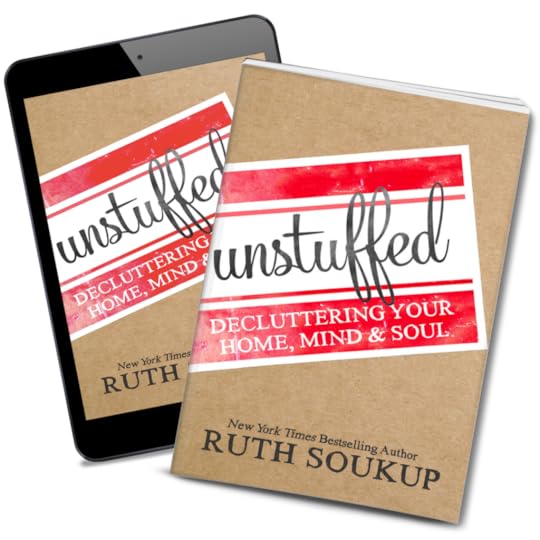 P.S. Unstuffed will be available in bookstores everywhere on April 5th! Packed with both personal stories and lots of practical tips, it is a must read for anyone who feels like their life has been taken over by STUFF, whether it be the clutter in our homes, an overbooked schedule, or just a serious lack of balance. When you order now, you can also get instant access to more than $75 in exclusive bonuses! Get all the details HERE.
P.S. Unstuffed will be available in bookstores everywhere on April 5th! Packed with both personal stories and lots of practical tips, it is a must read for anyone who feels like their life has been taken over by STUFF, whether it be the clutter in our homes, an overbooked schedule, or just a serious lack of balance. When you order now, you can also get instant access to more than $75 in exclusive bonuses! Get all the details HERE.
Pin It
The post Why We Say NO to Gifts appeared first on Living Well Spending Less®.
March 29, 2016
Join the Unstuffed Challenge!
Some of you may have already seen this here on the blog or on Facebook, but I wanted to let you know about a fun new challenge weâve put together in conjunction with the release of my new book, Unstuffed, and officially invite you to join me in clearing the clutter in our lives through the Unstuffed 10-Day Challenge.
Over the course of ten powerful video challenges, youâll be inspired to calm the chaos in your home and schedule, and instead implement simple solutions that work. From pillows to paperwork and everything in between, this is one powerful decluttering challenge you wonât want to miss!
The challenge is completely free to join, and all ten videos will be sent right here to your inbox. To sign up, simply click the button below.
Pin It
The post Join the Unstuffed Challenge! appeared first on Living Well Spending Less®.
March 28, 2016
How to Transform Your House into the Home You Want
Big news friends–my new book, Unstuffed: Decluttering Your Home, Mind & Soul, arrives in bookstores everywhere on April 5th. It is a message that is near and dear to my heart, and I can’t wait to share it with you! Jam-packed with both personal stories and practical tips you can implement right away, it tackles the big question we are all facing–how can we take back our life from all the STUFF weighing us down? Order now to get $75 in bonuses! Get more info at www.unstuffed.com.
Dorothy said it best–there’s no place like home. It’s the place where you seek sanctuary from the rest of the world. It’s the place where your family spends time together. It’s the place where you feel most comfortable and relaxed. It’s the place you live your life.
But when it’s cluttered and full of stuff, it’s hard to think of your house as a restful dwelling. Instead, it feels chaotic and stressful. Piles of paperwork, items to sort, and things to clean up become constant reminders of all the things we need to face and take care of. It can be truly overwhelming.
But it doesn’t have to be.
You can take back your space and turn your house into the home you want. You can create a welcoming space that is a reflection of who you are, one that encompasses your own family values and preferences, and is filled only with the things that give you joy and fulfill your needs.
Look around your home. What feelings does it evoke? Do you feel calm and at peace as you look around? Are the personalities and talents of your family members reflected and celebrated? Does your home emulate your relationship with God and those you love? Does it feel like a place of safety and comfort?
When it comes to your home, there are a number of questions you can walk through to guide you toward creating the space you want. We go into this topic in depth in my book Unstuffed, but I’d like to share some of these questions with you here today, so you can get a jumpstart on the process…

How Do You Use Your Space?
If you’ve read this blog for a while, you probably already know that I just love to entertain. I love throwing creative themed parties, but I also I like hosting a simple get-together with just a few close friends. I enjoy the buzz of a family dinner when everyone is contributing and discussing the ins and outs of their day. For me this means that my home needs to have space for hosting–an extendable table that easily seats 12, and lots of space to sit down.
And while we do love to entertain, we are also a family of readers. While a huge library with floor-to-ceiling bookshelves and a ladder isn’t exactly realistic with our current space and layout, we do have a small library area and a reading corner where we can enjoy all our books.
For other families, a dedicated space for reading might not be important, but a space for sewing or crafting could be, or they might just want a nice place to relax and watch movies. Perhaps they use the space for inspiration to create art or music. Perhaps their home is reflective of their children’s talents.
If you’re a chef or an avid baker, then a house with a well-stocked kitchen might make you feel right at home. If your family loves movie night, then having your DVDs on display and your comfiest couch in your living room probably makes sense.
Reflect on how you use your space now and what you really value about your home’s layout and arrangement. What activities are most important to you and your family? Does your home reflect this? If not, what changes could you make right now to get it so that it does?

What is the Role of Your Home?
Some of us see our homes as a hub—a place we gather to do all kinds of different activities. If you work from home, you might also see your home as an office. If you teach school at home, your home is a place of education and learning as well.
Understanding the role of our home gives us a clear picture of how our home can meet the needs of our family. Do your children need a quiet desk where they can do their homework or do they prefer to work from the library? Do you do crafts at home? Is your home a workshop or studio as well? Is your home a gym or do you exercise outside? Think of the many roles your home can play and the overall role as well. For some, we sleep, shower, dress and eat at home, then spend much of our day away. Others of us spend nearly all our time within the walls of our house.
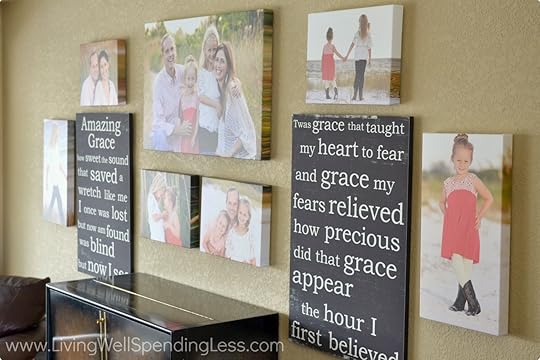
How Does Your Home Make You Feel?
Do you feel proud of your home when people stop by? Does your home make you feel safe, cozy and calm? Is your home disorganized and chaotic, adding to your stress? Is your home fun and reflective of your family values, your talents, and your memories?
Really assess both the current feelings you get from your home and what you think your home should feel like. When people walk in, do you want them to feel calm, reverent, or formal? When you walk in, how do you want to feel?

How Does Your Home Serve Your Emotional & Spiritual Needs?
Does your home help you feel calm and centered? Often, when our homes are full of stuff, disorganized and messy, we’re actually trying to fill a void or we’re buying items in the hopes they’ll make us feel better. In reality, it’s time to examine our emotional and spiritual state to reflect on where our needs are not being met. When you feel emotionally and spiritually fulfilled, you will no longer feel the need to clutter your life with excess, and to hold onto connections with items, rather than connections with people.

When You Decide to Begin Rearranging Your Space…
When you’re reorganizing and uncluttering your home, you’ll probably need to do some rearranging and redecorating. As you work on the layout of your rooms, think about the purpose of each room, and the job of each and every item within each room.
There’s a famous rule by William Morris that advises the following: Have nothing in your houses that you don’t know to be useful or believe to be beautiful.
Generally speaking, this rule should apply to almost every item in our homes. Because here’s the thing–we often decorate our homes based on how we THINK we should use our homes, rather than how we actually use them. Give yourself permission to be realistic.
While you may envision grand and formal layouts, with furniture and décor you’ve always dreamed about the reality is that if you have children and pets and a busy schedule, a formal décor may not serve you. Arranging rooms so they’re comfortable and functional is key to transforming your house into the best home possible for you and your family.
It can sound unattainable or difficult, but when you reflect on the true value of your family, your friends, and those who bring you spiritual and emotional nourishment, you realize it’s the people in your life that really matter. It’s not about having the most perfect home or a home that’s full of designer furniture, toys, clothes and “stuff.”
Start small when you declutter and repurpose your space. As you work to unstuff your life, work a little at a time, breaking off small pieces that you can tackle in a day or two. Build on these victories and organize a little more as you go. When you understand each room’s purpose and its role in your home, you can work toward a home that reflects the needs of you and your family.
Pin It
The post How to Transform Your House into the Home You Want appeared first on Living Well Spending Less®.
March 25, 2016
How to Model Healthy Money Habits for Your Kids

I am always happy to welcome back my friend Cherie Lowe from the Queen of Free, who has graciously joined us here at LWSL as a regular monthly contributor. Cherie is the author of the amazing book, Slaying the Debt Dragon, which she wrote after paying off more than $127,000 in debt! I love being able to bring her wealth of knowledge & experience on this subject to LWSL–please join me in making her feel right at home!
* * *
This is a Guest Post from Cherie at Queen of Free
I’ll never forget the first time I overheard her speaking in that tone of voice. It seemed so final, so harsh, so ugly. Hunched over her baby doll, her voice intoned with inflections of anger and critical disappointment. I knew where the words originated and why the very imitation of voice sounded so familiar. Both had tripped from my mouth hours before.
Is that what I really sound like? Is that all she hears when I speak?
The experience occurred nearly a decade ago but I can picture my then three year-old daughter’s visage and still hear her phrases distinctly. I’ll be honest that it was one of my finer parenting moments and ever since then I’ve tried to be more intentional with my words (even though I still lose my junk upon occasion and fall short).
It’s not that my daughter didn’t need correction for her behavior. Every toddler needs boundaries and instruction. However, her mini-me impersonation made me realize that actions often speak louder than words and that children often hear what we say but more often, they model what we do.
Teaching kids about money can be a daunting pursuit. We look for books at the library to read at bedtime. We make cute little Mason jar banks with the words “Give,” “Save,” and “Spend” elegantly penned on chalkboard stickers. We research a curriculum or we start a savings account. We create chore charts and abound with all sorts of grand intentions. And then life creeps up on us.
The books head back to the library. The jars have a few pennies at the bottom. And the stray check marks on the chore chart were from three months ago. It’s challenging for even the most intentional, goal-oriented parent to keep up with a familial personal finance education and tend to all of the other areas of child rearing, too.
Maybe we have it all wrong? Maybe it really is true that more is caught than taught. And perhaps instructing kids about money has less to do with adorable banks and more to do with our own personal behavior. Will someday they imitate our financial habits in the same way they imitate our disciplinary voices?

Relax Already
The good news for both you and me is that we don’t have to stress ourselves out over teaching a four year old about mortgages or a fourteen year old about annuities. Certainly if your child has a passion about either of those things, you can lean into their gifts and provide instruction. However, you don’t need to develop a comprehensive curriculum that would make Dave Ramsey cry tears of joy.
However, this is not an excuse to throw caution to the wind with a careless attitude. Simply put, parents will all have different approaches to teaching their children about money and that’s OK. You’re not condemning your child to a life in a pauper’s prison by missing out on the wrong book or neglecting your chore chart. Stop placing such a high burden on yourself and start enjoying the process instead.

Actions Speak Louder Than Words
Want your children to live a life unencumbered by debt? Pursue a debt free lifestyle yourself. Long for your sons and daughters to be savvy savers? Adopt those practices yourself. Instead of preaching to your kids, begin practicing what you dream for them.
Get your emotional spending habits under control. Learn how to budget monthly. Begin planning meals. And then invite your children into the process. Your words do make a difference in the life of your child; however, if your behaviors don’t match up with those truisms, your kids will quickly catch on. They need to see you regularly and healthfully interacting with money.

Maximize the Most Teachable Moments
The most valuable life lessons are rarely learned inside a classroom. Most of us don’t point back to a conference or formal lecture. Instead, those principles that guide our lives were informed by daily interactions with our first teachers – our parents. From good record keeping to generosity, you have the opportunity to educate your children in the ordinary stuff of life.
Whether you choose to make the mundane task of grocery shopping a learning experience or have your child help you fill out a budget form, everyday activities will stick with your child more than a seminar. Play “bank” and let your child mark enter pretend deposits and withdrawals on an old check register. Explain where money comes from (working) when you hit up the ATM. Skip plastic purchases (even if you use a debit card) and opt for cash that your child can help count at the checkout. These “along the road” activities on a regular basis will help impress upon them valuable lessons to last a lifetime.

Watch What You Say
While actions really do speak louder than words, what you say still counts. Regularly repeating phrases like “We can’t afford that!” or “It’s not in the budget!” might be setting your child up for failure in the future. Always speak the truth – sometimes you really can’t afford a trip to Disney World or a new toy – but think through how you say what you say. Give a fuller, age appropriate explanation whenever possible.
As much as I want to reel out the “Because I’m the mom and I said so!” mantra, sometimes it’s not my best practice. I have to take a deep breath and remember that I’m shaping and molding my child’s character with each word. It takes more energy (which often I lack), but it is really worth it.
From constantly complaining about not having enough money to criticizing your spouse about purchases, your children are watching and listening to every conversation. Tame your tongue and try to make your words count. We all blow it from time to time, but merely being mindful can make a big difference.
In the end, parenting is not for the weak of heart or spirit. But I know that you are bold and courageous enough to guide your children through to adulthood. Simply reading this article reflects that you want the best for their financial futures and that speaks volumes about your own character. You can do this. Passing on healthy money habits doesn’t have to involve a hefty syllabus or required reading list. Resourcing yourself never hurts, but there is no end-all be-all strategy for pediatric personal finance training. When you fail (because we all do), return to square one and begin again, focusing on your own personal choices as you teach your kids how to healthfully interact with money. Make the most of the everyday money moments of life, for they are ripe with potential to teach lessons to last a lifetime.
Cherie Lowe is an author, speaker and hope bringer.
Her book Slaying the Debt Dragon details her family’s quest to eliminate over $127K in debt in just under four years. As her alter ego the Queen of Free, Cherie provides offbeat money saving tips and debt slaying inspiration on a daily basis.

Pin It
The post How to Model Healthy Money Habits for Your Kids appeared first on Living Well Spending Less®.
March 23, 2016
Slow Cooker Stroganoff

It is always good to have a few recipes that you can whip up out of the pantry staples you already have on hand. It’s even better if those recipes also happen to be freezer friendly so that you can simply throw the ingredients together in a bag and freeze them for a later, busier day. And if the recipe happens to ALSO be a family favorite that your kids and husband just love? Well then quite frankly, that’s a recipe you just can’t live without.
This Slow Cooker Stroganoff literally comes together in just minutes, including the time it takes to brown the meat! For a vegetarian version, use vegetarian protein crumbles instead of ground beef.
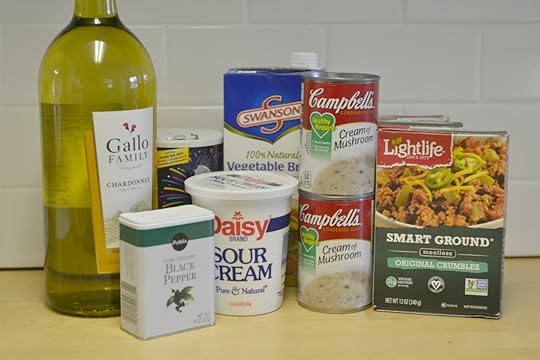
Here is what you need:
2 pounds ground beef or vegetarian crumbles
1 sweet onion
1 teaspoon minced garlic
2 cups white wine
2 cups vegetable broth
2 cups sour cream
2 cans cream of mushroom soup
½ teaspoon pepper
1-2 teaspoons salt (to taste)
1 8oz package sliced Portobello mushrooms
2 packages egg noodles ( 1 per cooking day only)

Step 1: Brown ground beef or vegetarian crumbles; drain beef if necessary and set aside.

Step 2: Finely chop onion and set aside.

Step 3: In large bowl, whisk together onion, garlic, wine, broth, sour cream, mushroom soup, salt, pepper.

Step 4: Stir in mushrooms, and ground beef( or vegetarian crumbles).

Step 5: Divide mixture into 2 1-gallon freezer bags (Be sure to label bags first). Freeze until needed.

Step 6: On cooking day, place frozen contents of 1 bag directly into crockpot. Cook on high for 2-3 hours or low for 4-6 hours.

Step 7: Cook 1 package egg noodles per the package directions, then drain noodles and add to crockpot. Mix well and serve.

Print This!
Recipe: Slow Cooker Beef Stroganoff
Summary: This meal comes together so easy and can be made vegetarian friendly!
Ingredients
2 pounds ground beef or vegetarian crumbles
1 sweet onion
1 teaspoon minced garlic
2 cups white wine
2 cups vegetable broth
2 cups sour cream
2 cans cream of mushroom soup
½ teaspoon pepper
1 teaspoon salt
1 8oz package sliced Portobello mushrooms
2 packages egg noodles ( 1 per cooking day only)
Instructions
Brown ground beef or vegetarian crumbles; drain beef if necessary and set aside.
Finely chop onion and set aside.
In large bowl, whisk together onion, garlic, wine, broth, sour cream, mushroom soup, salt, pepper.
Stir in mushrooms, and ground beef( or vegetarian crumbles).
Divide mixture into 2 1-gallon freezer bags (Be sure to label bags first). Freeze until needed.
On cooking day, place frozen contents of 1 bag directly into crockpot. Cook on high for 2-3 hours or low for 4-6 hours.
Cook 1 package egg noodles per the package directions, then drain noodles and add to crockpot. Mix well and serve.
Preparation time: 5-7 minutes
Cooking time: In crockpot on high for 2-3 hours or on low for 4-6 hours
Number of servings (yield): 4-6

The post Slow Cooker Stroganoff appeared first on Living Well Spending Less®.
March 22, 2016
The Unstuffed Countdown Has Begun!
 This is not really a normal blog post, but I wanted to take a couple of minutes today to let you know about a project that I have been working on for almost two years now, one that is incredibly near and dear to my heart, and one that I absolutely can’t WAIT to share with you!
This is not really a normal blog post, but I wanted to take a couple of minutes today to let you know about a project that I have been working on for almost two years now, one that is incredibly near and dear to my heart, and one that I absolutely can’t WAIT to share with you!
Just two weeks from today my new book, Unstuffed: Decluttering Your Home, Mind & Soul, will be available in bookstores everywhere.
We’ve been getting lots of questions from readers who have been eagerly waiting for what seriously seems like FOREVER for this book to finally arrive, so I thought I would address a few of those questions, and also share a little of what’s on my heart regarding this book.
WHO IS THIS BOOK FOR?
Unstuffed was written for any woman who currently feels or weighed down by a home and schedule that seems chaotic, out-of-control, and completely overstuffed. It speaks to the mom who is overwhelmed by the vast quantities of STUFF that comes pouring into our homes, from trinkets and paperwork to endless obligations and activities.
WHAT IS THIS BOOK ABOUT?
It is not just a practical step-by-step guide to ridding our lives of clutter, but an insightful look at exactly why our lives become so stuffed—and what we can do to stop the madness, once and for all. It is real, honest, jam packed with practical tips, and truly speaks to the question we are all facing— how can we take back our lives from the stuff that is weighing us down?
WHAT CAN I DO TO HELP?
Can I just tell you that while I am so very excited to see all these months of work finally come together, I am also a little bit (okay, a lot) terrified? You see, I don’t really know how to do things halfway. When I wrote this book, I wrote it with my whole heart. And now my heart is out there for everyone else to see.
Crazy, right?
So while I would of course love for you to preorder a copy, in all honesty what I would love even more is if you could join me in praying that the message of this book will be heard by those who need it most, that it will bring hope and encouragement to women everywhere, especially those who are struggling to unstuff their busy, jam-packed lives.
And, if it’s not too much to ask, pray too that my sometimes-too-fragile heart will be protected from the naysayers and critics eager to tear me down.
IS THERE ANYTHING ELSE I SHOULD KNOW?
Yes! My team and I have put together an incredible bonus package for this book, one that we are SO excited to share with you! When you purchase the book at any book seller, you can fill out our form to get instant access to more than $75 in exclusive bonuses, including a 50 page workbook, videos, access to our Unstuffed app, a digital copy of 31 Days to a Clutter Free Life, and much more.
All the bonuses are hosted on a special members-only bonus site so you can keep them all in one convenient place, and don’t have to worry about adding MORE clutter to your life! These bonuses add incredible value to an already life-changing book, but they will only be available for a limited time.
Thank you in advance for all your support & prayers! It truly means more to me than you could ever know.
xoxo, Ruth
P.S. If you are the person who needs this book and want to know more about how to preorder, or simply want to know how you can help spread the word, please check out the book website at www.unstuffed.com.
Pin It
The post The Unstuffed Countdown Has Begun! appeared first on Living Well Spending Less®.
March 21, 2016
8 Great Ways to Clear the Clutter
Big news friends–my new book, Unstuffed: Decluttering Your Home, Mind & Soul, arrives in bookstores everywhere on April 5th.  It is a message that is near and dear to my heart, and I can’t wait to share it with you!  Jam-packed with both personal stories and practical tips you can implement right away, it tackles the big question we are all facing–how can we take back our life from all the STUFF weighing us down?  Order now to get $75 in bonuses! Get more info at www.unstuffed.com.
I’m not ashamed to admit that I am tad bit obsessed with decluttering.  The truth is, I still struggle with an attachment to STUFF, but I’ve also discovered just how much better life is with less.
In our modern lives, excess and stuff-collecting are common dilemmas. So often, we become bogged down and tied to taking care of our house, sorting through paperwork, finding homes for things we didnât really need to purchase, and just feeling generally overwhelmed by this pile of, well, everything that threatens to crash down around us at any time.
Whatâs so great about clearing the clutter? A clutter-free home makes for a clearer mind and a better life. Letting go of our attachment to STUFF allows us to focus on the things that matter most–things like faith, family and friends–and leaves us feeling less stressed and more organized.
If youâre feeling like the clutter is becoming too much to handleâhere are a few great ways to roll up your sleeves and get started!

1. Donât Bring It In
The first rule of clearing clutter: donât let it happen in the first place. If youâre already in a position where you need to tackle clutter (as most of us are), then commit right here and now to STOP bringing in more stuff.
Try a month of zero spending. Find a way to make do with something you already have. Repurpose items, get creative and âDIY.â Instead of ordering pizza or take out (more boxes and stuff coming in), see if you can make a restaurant meal at home.
The next time you buy something, stop to think if itâs something you really need. Itâs okay to treat yourself once in a while, but when you do, make it meaningful and useful. So often we think, âI deserve thisâ and find ourselves purchasing $30 candles, knickknacks soon forgotten, or clothing and accessories we wonât wear.
You deserve special things. We all do. But let go of the mentality that you must âtreat yourselfâ by spending money on stuffâespecially when you know it will only add to your clutter and your stress level.

2. Give Yourself Permission to Let Go
Many of us have sentimental attachments to our stuff, which makes it feel almost impossible to let go. But you can. If a loved one has passed, keeping their items can make us feel closer to them. Similarly, we can form attachments to things we associate with happy memories or times in our life we wish we could hold onto.
Unfortunately, our emotional baggage can become actual baggage in the form of clutter. Suddenly, weâre weighed down by the guilt and emotional toll these items have on our lives.
Give yourself permission to let go of the guilt. If you bought something you liked, but it doesnât fit your style anymoreâlet it go. If you received gifts you donât want or need, donate them to someone else. Giving still-useful items to charity can help us feel less guilty about getting rid of them. After all, youâre giving the item new life, and it will continue to serve someone else.

3. Get (and Keep) a Handle on Exactly What You Have
How often do we find ourselves running to the store for batteries or ingredients, when we know âitâs around here somewhereâ? It happens all the time. Clutter makes it hard to find the things we need, so we end up re-buying items, adding to yet MORE clutter.
Keeping your home organized can seem like an overwhelming task, but if you break it up into smaller bite-sized pieces, you can clear a lot more clutter a lot more quickly than you might think. When your home is organized, you can quickly inventory what you have on hand, and save yourself the trek to the store to buy tissues, cotton swabs, or peanut butter, when theyâre already hiding in a cupboard.
Try our 31 Days to a Clutter-Free Life challenge.  (Note–right now you can get 31 Days to a Clutter Free Life as part of our $75 bonus package when you order Unstuffed.  Get all the details HERE.)  Follow the schedule and clean up each day. Once you get your home organized, commit to keeping it that way. Make time and space for the important things and let go of what doesnât fit the bill.
Bonus: staying organized will also keep your schedule clutter-free. Time is one of our most precious commodities, because we all know: when itâs gone, itâs gone. If you feel life is racing by and you canât keep up due to schedule clutter, try filling a time jar. Itâll change your life.

4. Get Out of the STUFFÂ Mindset
Change your mindset to âexperiences over stuff.â In our family, we try to make memories, rather than giving gifts. For birthdays and holidays, it can be much more meaningful to do something exciting than it is to give another toy or accessory soon to be forgotten.
For your friendâs next birthday, take them out to coffee or a movie, and give them your undivided attention. (Cell phones off!) Take your kids to a museum, or spend time hiking, playing outdoors, or enjoying a park instead of going to the mall. Even taking a walk to the library and bringing home books can be an experience, which doesnât result in more permanent clutter.
Try family game nights, dinners at home, movie nights, and crafts. Youâll find new creativity unleashed and stronger connections made. When you have a date with your spouse, try just going for a walk, holding hands, and enjoying each otherâs company. Things donât have to be costly, fancy or tangible to result in memories.
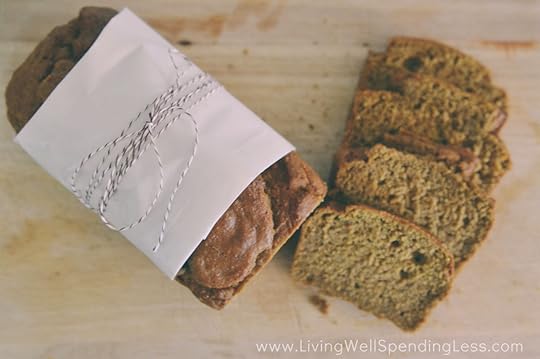
5. Create (Donât Buy) Gifts
Rather than giving more clutter to those around you, again, find ways to give experiences. Like the aforementioned coffee date or birthday lunch, giving the gift of a listening ear and time with a friend can be so much more meaningful than buying things.
If you hate to go to a party empty-handed (or itâs the holidays), itâs a great opportunity to create meaningful, handmade gifts. It can be much more special and fun to design something for a friend. I find spa items (salt scrub or candles, for example) make great gifts, and many can be created with ingredients on hand. Try making cards. Even if you arenât âartistic,â simply pasting a beautiful photo onto a blank card can make a lovely greeting to brighten the day of anyone who receives it. Fresh flowers or veggie treats from your garden like beets, carrots, fresh herbs, or lettuce make for a great âedible arrangement.â
When all else fails, cookies are a gift everyone loves to receive. Homemade bread is another. Put together a baked good and a card, and youâve given someone something beautiful they can enjoy without adding to their (or your) clutter.
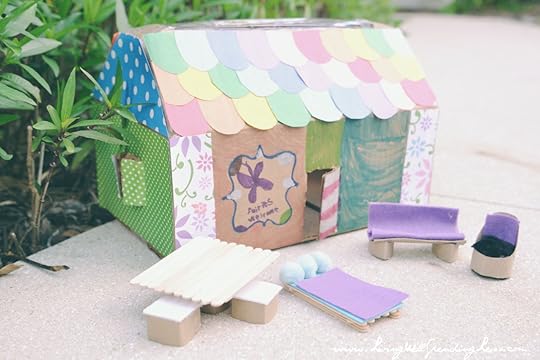
6. From Kidsâ Clothes to Kitchen, DIY and Get Creative
Give new life to old items by getting creative about your repurposing. âRefashionsâ are very popular online right now. Refashioning involves finding thrift-store items, then, with a few snips and stitches, turning them into beautiful, wearable fashions.
We all experienced âhand-me-downsâ in our youth, so some of us may have vowed to never let our children feel embarrassed about wearing âusedâ clothing. If youâre still harboring this mentality, itâs time to let it go. Weâve gone to the opposite side of the spectrum now, where many of our kids have closets full of clothing which would have put even the most fashionable woman in our grandmotherâs day to shame.
When it comes to kidsâ clothing, most items have much more life left in them, even after day-to-day wear. Swap clothing with a fellow mom or donate items your kids have outgrown.
When it comes to kidsâ toys, you know I believe less is more. Weâve found, with fewer conventional âtoys,â our children were able to better develop their imaginations, exercise more creativity, and show more of their artistic side. So many popular toys today tell kids what to do or how to play. Our girls have made whole fairy villages out of items in the garden and doll dresses out of tissues and marker. Theyâve even written stories and playsâall out of their own imaginations.
Oftentimes, we spend money on new stuff, even though we have something on hand that already fits the bill. Kitchen gadgets (and again, kidsâ toys) are two areas where getting creative can usually fix the problem without spending a dime at the store. In the kitchen, most chefs will tell you a knife, cutting board, grater, peeler, and maybe a few spatulas will get you pretty far. You donât need a fancy mandolin, spiralizer, slap-chopper, and all those other one-trick ponies that clutter up kitchen counters and drawers.
The great thing about buying less stuff? Youâre creating less waste clutter AND less waste. Itâs win-win!

7. Opt for Less Packaging
Speaking of buying less stuff, when given the option, purchase the item with the least packaging. Less packaging = more space. Itâs that simple. For bulk items, bring your own bags or (better yet) uniform, stack-able containersâfill them up by the pound and stack them neatly in the pantry. (This tactic is also great for your wallet! When purveyors donât have to pay for packaging, they can charge much less for grains, dried fruits, baking goods, herbs, and other bulk items.)
A word of caution: donât save all that packaging. If you donât plan on using the box, bag, or container within a week, send it to the recycle bin. Itâs easy to start storing boxes, until one day you find yourself with a closet or basement full of them.
Try to reduce your garbage as much as possible. After all, garbage is Earth-clutter. Use reusable containers for lunches and food storage (glass containers are better for your health anyway), and try composting to give your garden a healthy boost and reduce your table scraps. Most communities offer recycling programs for glass, metal and paper waste. When used properly, they can really cut back on your household waste.

8. Go Paperless
Paper clutter can be one of the most overwhelming problems to tackle, and yet, once itâs addressed, itâs one of the easiest to manage. The first rule of thumb is to go as paperless as possible. Again, so many of us have this mentality that we need tangible items to hold onto, yet today, so many things are available digitallyâwell, thereâs hardly a need for paper clutter at all.
Whenever possible, opt for digital when it comes to books, magazines, movies and photos. I love my Kindle and I love that digital subscriptions and purchases are often much cheaper. Remember the days of records, cassettes and CDs? Now nearly everyone uses mp3s or digital streaming services to store and play music. Think of the space and clutter saved!
When it comes to documents, photos, and even articles and ideas you want to save, simply snap them with your smartphone. This works great for receipts and other documents, when you may just need a copy for future reference.
Whenever possible, opt for paperless billing. When you receive mail, check to be sure youâre signed up for the most paperless option, whether itâs your insurance company information, your portfolio management service statements or your electricity bill. Be proactive about unsubscribing from junk mail and catalogs. If you can find it online, why waste the postage, time and energy to send a paper copy?
Clearing the clutter from our lives is freeing, plus it stimulates our creative side. It gives us space to grow and enjoy time with our kids and our spouse. It keeps our schedules free too, as we no longer have to search for things, shop for things we donât need, and sort through things we shouldnât waste our precious time sorting.
Let go of the clutter and you may find you have more room for the things that matter most.
Pin It
The post 8 Great Ways to Clear the Clutter appeared first on Living Well Spending Less®.
March 18, 2016
20 Supermarket Traps to Avoid
How many times have you gone to the grocery store for one or two items and left with a whole cart full? I know it’s happened to me, more than once—and it’s definitely not good for anyone’s budget!
Grocery stores (and all stores, really) spend big bucks on researching consumer psychology and putting it into practice. It’s not just your imagination, so if you’ve fallen for these tricks, it’s not your fault. It happens to the best of us. These tricks are meant to get you to open your wallet and impulse buy.
Understanding a few of these little psychology games that supermarkets play can ensure you don’t fall for them, so you can shop smart and save big when you make your next trip to the store. Watch out for these supermarket tricks…!

1. Delicious Smells and Sights at the Entrance
From the moment you walk into the store, the supermarket planners have worked to carefully tempt you to put more items in your cart. Often, bakery and flowers are placed right up front. You walk in the store (or even the entryway) and you’re greeted with beautiful plants and delicious looking treats. You’re in a good mood, your cart is empty, and what do you do? You add a few of these items to your cart! Rotisserie chickens and seasonal produce are also placed near the front for the same reasons. You smell that amazing smell and your salivary glands go into overdrive!
2. Big Carts
Grocery carts have grown over the last 10-20 years (just like our waistlines and portion sizes). Consumers will spend more when they have a bigger cart. Don’t fall for it! If you need only a few items, opt for a basket rather than a cart. Carrying the basket through the store will help you keep a handle on how much you’re purchasing.
As carts get bigger, aisles get smaller and narrower. The idea is that it’s more of a challenge to turn around, so you’ll naturally be led to the back of the store.
(Side note on carts: they’re rarely, if ever, cleaned off. So the next time you go in the store, use the free hand wipes to clean the handle. Who wants someone’s leaky chicken juice or sticky soda all over their hands? Or the kids’ hands?)

3. Produce First
There are several tricks in the produce department. The first one: produce is usually the first section you hit, right before the bakery and deli. Why is that? Well, the idea is you’ll be so proud of yourself for putting these healthy items in your cart that you’ll reward yourself by purchasing less healthy items next.
Don’t fall for it! While you should, of course, fill your cart with fresh produce, don’t deviate from your list. Pat yourself on the back in other ways—like by saving when you reach the register.
4. Glistening Produce
The next trick you’ll face in the produce section is that lovely “mist.” (I’ve even heard grocery stores play Singin’ in the Rain when the spray comes on.) What does the mist do, exactly? Well, for one thing, it actually isn’t great for the produce and can make it rot faster. It makes it glisten and look fresher, though—dewy lettuce, glowing apples, crisp carrots—they all look better sporting the “wet look.” Be sure to dry off your items when you get them home; extra moisture in the bag can make things go bad much quicker.

5. Pre-Cut and Packaged Produce
Another thing you’ll find in the produce department is pre-packaged fruits and veggies and pre-cut items. If you really want to save money, these items will cost you quite a bit more. Want proof? Compare “baby carrots” with regular old carrots. The price is almost half. Not to crush your fondness for baby carrots, but they’re just regular ol’ carrots cut smaller. Save money and chop produce yourself.
Bagged lettuce and pre-packaged peppers can seem like a good deal, but you’ll be able to select fresher items individually. Not only that, but you won’t end up buying four lemons, when you really only need one. Supermarkets package these items to get you to buy more, to hide blemishes and other signs of age, and because they know you’ll fork over more cash for convenience.
6. Fancy Cheeses
Now, I love a good brie or Camembert as much as the next gal, but often the cheeses in the “artisan” cheese case are priced double or triple over what you’ll find in the dairy section. For a party or get together a fancy cheese is fun, but if you’re just looking for cheddar, head back to the dairy section to save more money.

7. Dairy and Eggs in the Back
Speaking of the dairy section, have you ever wondered why it’s in the back of the store? Well, the reasons are twofold: 1. To get you to head to the back or middle of the store for essential items like milk, cheese, butter and eggs; and 2. Because when it’s unloaded off the truck, it gets these heavy items in the fridge faster.
While the food safety precaution is appreciated, don’t be distracted on your way to the dairy section! You may also notice all those delicious cookies and other yummy items that pair well with dairy located right in the dairy aisle or facing the case (lest you get to the back of the store forgetting Oreos exist).
8. Multiple New and Exciting Flavors
About those Oreos…and Doritos and salad dressings and cereals—have you ever noticed how there are SO MANY FLAVORS?! Yet, when you try them, you have to admit, they’re often pretty darned similar. Take, for example, the special holiday packages of Peppermint Oreos vs. the regular Cool Mint Oreos. The differences are subtle at best but companies know you’ll pay more for exclusive, new and different flavors.
We love variety and don’t want to miss out on the “new.” Cereals use this trick all the time: Lucky Charms offers a different shaped marshmallow or Wheaties puts a new sports star on the box. Consumers will pay more for variety. Just be sure you aren’t falling for a more expensive variation on something that’s not so exciting.

9. Expensive Items at Eye Level
Expensive, premium brands are housed at eye level to keep them in the customer’s view. The less expensive and store brands are often kept lower or higher. Keep in mind as well that children’s items like fruit snacks, cereals and animal cookies are often kept at kid-eye-level, so you can be sure to hear that constant “But, Mo-om, pleeeease?”
10. Samples, Samples, Samples
If you’ve ever been to a supermarket on sample day, you know you can easily fill up on the various treats you’re offered. There’s a certain level of commitment that happens on the part of the consumer’s psychology when they try a sample. It’s much more difficult to pass up a box of something or a new treat once you’ve earnestly been offered a taste. Samples sell products (and often items you wouldn’t have put in your cart otherwise).
It also goes back to the “new” and “exciting” selling point that attracts consumers. We all love to be the first to discover a new treat or bring home something different for our families. By trying a sample of a new flavor of yogurt or ice cream, we feel a certain obligation to then bring it home to share.

11. Premium Selections at the Deli, Meat & Fish Counters
Purchasing items at the meat and deli counter often costs a premium and doesn’t necessarily mean a fresher or better product. Meat, and fish in the frozen section are almost identical to what you would receive at the counter, but you’re paying for the ability to make a selection.
What’s more, look at the fine print in the fish case. Often, the fish is marked “previously frozen” which means you actually need to use it up right away, as opposed to fish that’s still frozen in the freezer section (and was probably fresher at time of freezing).
12. Bulk Items that Aren’t a Bargain
Purchasing items in bulk seems like it’s always a better deal…and grocery stores know that and use it to their benefit. Sometimes those bigger packages aren’t actually saving you money and they’ll end up going bad before your family can use them up.
On the bottom of each sticker, there’s often a unit price (price per ounce or unit of measure). Compare the unit prices of items to see if you’re really saving money. You might be surprised to discover the family-sized bag isn’t always the best bargain. This also goes for warehouse stores as well—so shop smart to make sure you’re really saving on your big purchases.
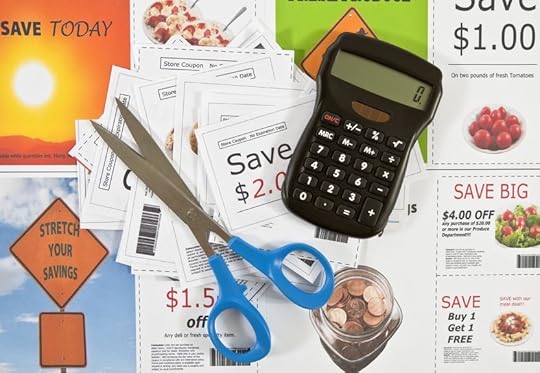
13. Tricky Coupons and Offers
Supermarkets know customers can’t resist a sale or a bargain. So, what happens? Often, they mark items UP before marking them down. Many of the items advertised in the weekly circulars aren’t actually big savings items. This is when it’s time to consult your Rock Bottom Price List and compare to see if you’re really saving.
Similarly, coupons and offers of “buy one, get one 50% off” or coupons that have to be combined with other offers can be tricky to use. Some higher-end brands are more expensive than store brands, even with a coupon. Also, be cautious to read all the fine print on a coupon and be sure you’re purchasing items your family will actually like and use. Use smart coupon strategies to stretch your dollars.
14. Changing Layouts
I don’t know about your grocery store, but mine remodels and changes item locations…often. There’s a reason behind this. Markets know that if you get too comfortable with your shopping trip you won’t have to search for your preferred items. If you don’t search for your items, you might not get drawn into impulse buys—so they keep you looking.
Aisles are long and hard to maneuver if you want to turn back because they want you to walk aisles in their entirety. They also add end caps filled with seasonal items (think canned green beans, fried onions and cream of mushroom soup at Thanksgiving; or condiments and tail-gating goodies during the summer). These end-caps aren’t selected because they’re great prices (or often even on sale at all). They’re selected because they’ll get your attention.

15. Getting You to Join their Club
Club cards and savings cards are pretty much the norm at supermarkets these days. They often have savings attached to them, but they’re also valuable resources supermarkets can use to analyze your spending habits, note items that are selling together, and target various demographics.
This consumer data adds a valuable layer to their market research and tells stores what they need to know about their shoppers. These club-exclusive offers also draw customers in by helping them believe they’re getting unique and special offers or saving more by joining.
16. Unclear and Tricky Signage
How often have you seen signs between two items (usually one regular-sized and one slightly larger) and been unsure about which item was on sale? Stores can make signage unclear so customers will pick up an item and forget to watch for the sale by the time they get to the checkout counter.
Most of us don’t write down prices or remember the shelf sticker for everything we buy, so by the time we get to the checkout, it can be hard to recall or even notice when your sale price doesn’t come up. If you do notice something, though, it can be worth it to speak up. Many cashiers will give you the sale price if the sign is confusing or the adjustment is under a certain amount.

17. Slow Muzak
Grocery stores often use music to train our senses into relaxing and taking our time. If you listen to upbeat jazzy music, you’re more liable to move quickly through the store and miss a chance to fill your cart. Slow, familiar pop favorites or instrumental music causes consumers to zone out and shop along to the music.
18. Sales on Multiples
Did you realize that when sales say “10 for $10” or “2 for $5” you often can buy just one for the sale price (rather than 10)? Look at the fine print on the sign, and unless it specifies that you must buy all the items to qualify for the sale price, you don’t need to buy the “suggested amount.”
Stores know most people will simply buy the number of items the sign suggests, which might be more than you actually need. Also, use caution and check your Rock Bottom Price List to compare. If a normal price is .89, or 5 for $5, you’re not saving a thing.
19. Using 99 Cent Pricing
Retailers have known for years consumers gravitate toward $.99 pricing. Think of the last time you saw an item priced at an even amount—like $3.00 as opposed to $2.99. That one-cent tricks our brains into thinking we’re paying a dollar less for the item. It’s an old trick, but one that retailers use time and time again because it works.
Even stranger, given two items, one at $1.99 and one at $2.09, we often feel we’re saving much more on the first item than just $.10. So, an item that’s just slightly marked down appears to be a much better deal than it actually is.

20. Impulse Buys at the Checkout
If you’ve made it all the way through the store with the integrity of your list still intact, you may have to stifle the urge to reward yourself with a soda, candy bar, magazine or gum once you hit the cash registers. There’s a reason stores put these items right at the checkout. They’re rarely on sale and they’re often lower priced luxury items and treats we feel we need to “reward” ourselves by purchasing.
Going to the store with a strong list in hand and committing to saving on food by sticking to your plan will keep you on track. Watch out for supermarket tricks, and make sure you aren’t hungry when you make your trip. Watch for subtle ways grocery stores try to tempt you into spending more—and RESIST! You can do it!
Pin It
The post 20 Supermarket Traps to Avoid appeared first on Living Well Spending Less®.
March 16, 2016
Easy Garlic Chicken

It’s no secret that we LOVE quick & easy freezer meals around here, especially ones that use budget-friendly chicken! Although it might sound intense, this tender garlic chicken actually has a very mild flavor that even the pickiest kids can handle. Better yet, it goes straight from the freezer to the crock pot, and you can even throw in a few carrots and potatoes to make it an effortless one pot meal.
To make it as part of a freezer cooking day, just split the broth & chicken into multiple bags, then throw it right into the freezer–no cooking required! Making it ahead of time is not necessary, though, as it is equally delicious just marinated in the refrigerator.
You can use any type of chicken but my family much prefers the boneless, skinless chicken thighs, which are a darker, juicier meat and also tend to be cheaper than the boneless skinless breasts.
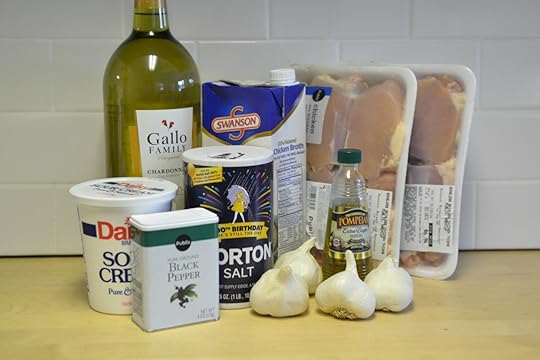
Here is what you need:
¼ cup olive oil
2 cups white wine
2 cups chicken broth
2 cups sour cream
½ teaspoon pepper
1 teaspoon salt
3-4 pounds boneless, skinless chicken thighs
20-30 whole cloves of garlic
6 sprigs fresh thyme (optional)
baby red potatoes & baby carrots (optional; for cooking day only)

Step 1: In large bowl, whisk together olive oil, white wine, chicken broth, sour cream, salt, & pepper.

Step 2: Divide chicken into 2 1-gallon freezer bags ( be sure to label bags first), then divide garlic cloves and thyme into bags over top of chicken. Then divide broth mixture over top of chicken. Freeze until needed.

Step 3: On cooking day, place frozen contents of bag directly into crockpot. Cook on high for 4-5 hours or low for 7-8 hours.

Step 4: If desired add baby potatoes and baby carrots for last 2-3 hours of cooking time.

Print This!
Recipe: Easy Garlic Chicken
Summary: Love garlic then this is the dish for you!
Ingredients
¼ cup olive oil
2 cups white wine
2 cups chicken broth
2 cups sour cream
½ teaspoon pepper
1 teaspoon salt
3-4 pounds boneless, skinless chicken thighs
20-30 whole cloves of garlic
6 sprigs fresh thyme (optional)
baby red potatoes & baby carrots (optional; for cooking day only)
Instructions
In large bowl, whisk together olive oil, white wine, chicken broth, sour cream, salt, & pepper.
Divide chicken into 2 1-gallon freezer bags ( be sure to label bags first), then divide garlic cloves and thyme into bags over top of chicken. Then divide broth mixture over top of chicken. Freeze until needed.
On cooking day, place frozen contents of bag directly into crockpot. Cook on high for 4-5 hours or low for 7-8 hours.
If desired add baby potatoes and baby carrots for last 2-3 hours of cooking time.
Preparation time: 5-7 minutes
Cooking time: 5-6 hours on high or 7-8 hours on low in crockpot
Number of servings (yield): 4

Pin It
The post Easy Garlic Chicken appeared first on Living Well Spending Less®.
March 14, 2016
How to Master Make-Ahead Meals
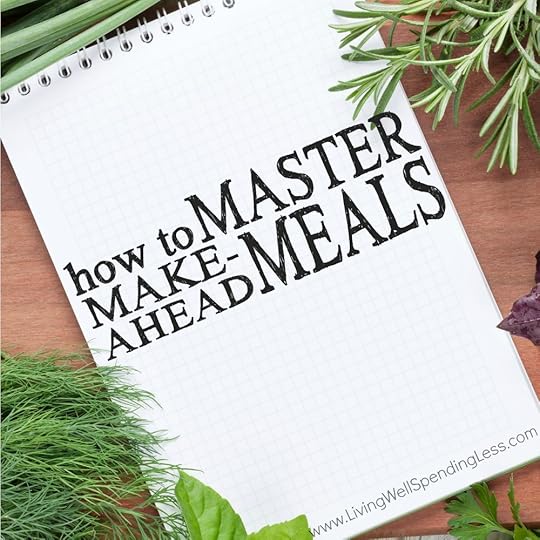
If you’ve read this blog for any amount of time, you may have noticed that I am a pretty big fan of freezer and make-ahead meals. It’s something I started doing regularly a few years back to help us save time and money, and bring a little sanity back to our busy lives.
To be honest, I also started it because I’m not a big fan of “fancy” cooking on a day to day basis. I don’t hate cooking, and when I actually set aside time for it, I really enjoy it. But the reality is that gourmet cooking takes a lot of time and right now, in this busy season of life, gourmet meals are not my priority.
When we started enjoying freezer meals, I stuck to dishes that could be prepped in just an hour or two over the weekend. I love having a freezer full of meal options, so I can simply pop something out of the freezer and into the crockpot in the morning (or into the oven at night), set the table and be ready to eat.
At first, my husband took a little while to come around. Let’s face it: many of us were traumatized by crockpot food in our childhood. Bland soups cooked beyond recognition seemed unappetizing and well…gross. I made it my goal to shoot for healthy and simple freezer meal recipes, created with “normal” ingredients most of us have on hand, that also passed the hubby and kid taste-test.
For some of us though, freezer meals just don’t work for every day. Maybe your family isn’t a fan of crockpot meals or maybe you simply have a very small freezer, so storing 10-20 meals ahead of time won’t work for your family. There are still some simple ways you can prep meals ahead of time on weekends (or even on one weeknight) to keep yourself out of the kitchen and out doing more of the things you enjoy. (You can always try our Sunday Prep Guide, too. Just follow the instructions and you’ll have 10 meals prepared for the whole week in just one day, plus, you’ll accomplish more than you ever thought possible in just a few hours.)

1. Always Have a Plan…and a List
I keep a go-to list of my family meal favorites. We usually have the ingredients we need on hand, so I can whip up at least a few of them in a pinch. Keeping a stockpile of items like pasta, tomato sauce, rice, dried beans, and other shelf-stable items in an organized pantry helps ensure you can cook up a quick meal with minimal hassle.
Before tackling your meals for the week, set aside some time the day before you cook and prep to take a little inventory. Check what you have on hand and plan meals incorporating those ingredients, and/or write up your grocery list and grab the items you’ll need. Be sure to check for staples like olive oil, spices, sugar, salt, and flour. (It’s so frustrating when you’re all set to start cooking and you have to run back to the store for one key ingredient!)
I’m a big fan of substituting items I don’t have on hand. Depending on your level of comfort with your recipe, you can often make do with something similar. No basil? Use parsley. No fresh mushrooms? Use canned. If you’re a by-the-book cook, be sure you check for everything first.
After I’ve inventoried my ingredients, I usually sketch out a little to-do list. I list out all the meals I plan to make, then I look for common ingredients. This saves a ton in prep-time and it’ll make your job much easier later on.
2. Stretch Your Ingredients
Using higher quality, fresh ingredients can help you get by with less. If you use fresh herbs in your recipes, you can get by with much less. On the flip side, dried ingredients are often much cheaper.
Being the frugal mama I am, I have learned to stretch certain recipes—replacing half the ground beef in tacos with cheaper beans or soy crumbles, for example, or adding veggies to spaghetti sauce to get away with using less meat. With cheese, try adding flavorful types (like blue cheese and real Parmesan) to pack a bigger punch with less.
Be wise with your ingredient usage. Meat and cheese are often pricey, so try adding rice and beans to dishes to make them go a little further. A thick, hearty sauce is always wonderful, but you can use starchy pasta water to thicken your sauce and still have a little left over to use for pizza.

3. Create Sides & Starches for Multiple Meals
My girls love mashed potatoes. I can easily make one large batch of mashed potatoes and then add them to dishes to complement meals throughout the week. For example, a great side to go with an Herb Roasted Chicken for Monday, then as the topping to my Shepherd’s Pie on Wednesday, and then added to my Loaded Cream of Potato Soup for Friday.
The same batch-cooking concept works great for starches. If I’m making an Asian rice-based dish for one night, then why not make a larger batch of rice and use it in coconut beans and rice or enchiladas for another meal? If the flavors of the meal are different enough, you won’t even notice you’re having the same spaghetti with marinara one day and with Thai peanut sauce the next.
4. Sauces & Bases That Do Double-Duty
Sautéed onions, celery, carrots and mushrooms form the base of many of my dishes. It’s pretty easy to make a big batch, and then divide it into three or four different dishes as I start cooking. Cooking stocks and many sauces also call for a similar process.
If I’m making two dishes using ground beef, I can brown the meat, then use the flavor from the pan to thicken two sauces. Then, I simply transfer half to one pan and half to another pan when I’m ready to start adding spices and distinctive flavorings. This is how one pound of ground beef, soy crumbles, or turkey might end up in a chili, a taco soup, and perhaps a pasta dish—all in one week.

5. Prep It Once, Use It Twice
One area of cooking I dread? The chopping. It seems to take FOREVER. And while you can save quite a bit of money prepping veggies and ingredients yourself, it really does take extra work. Since we’ve been growing some of our own foods in the garden, I often marvel at how much preparation goes into foods before they ever make it to our plates. Veggies need to be washed, peeled, chopped and prepped BEFORE they get cooked and seasoned.
In keeping with the time saving idea of make-ahead meals, be sure you’re prepping smart. Refer to your list and look for overlapping ingredients. If you have a lot of slicing and dicing to do, can you start the rice cooking, get the pasta boiling, or pop something into the oven to roast, so you’re doing double-duty? If you can get your onions and base-veggies chopped first, they can sauté while you prepare other items.
6. Freeze It, Don’t Waste It
Even if you don’t want to freeze an entire meal, sometimes when you’re prepping meals for the week, you end up with extras of certain items: lemon juice, herbs, broths, tomato paste, or a half can of pumpkin. When this happens to me, I just freeze the items for later. Herbs can be easily frozen in a little bit of olive oil in ice cube trays. Lemon juice and tomato paste can be frozen the same way. Other canned items can be transferred to a freezer container and simply tossed into another dish next week!
You can even save your veggie scraps to make stock later on. Keep a freezer bag on hand and stash the cleaned peels, ends and stalks of vegetables for later, to make a flavorful broth you can use for the base of soups, stews and other dishes.

A Word About Food Safety
When you make meals ahead of time, you don’t want to leave anything lingering in the fridge for days and days. If you prepare your items for the week on Sunday, by Friday, certain foods may be starting to reach the point of no return. Vegetables and sides (like rice and grains) can hold their own through the end of the week. Pasta gets a little gummy and hard after a few days in the fridge, and protein like chicken and pork should be eaten within three days of cooking.
Never take risks with food safety. It’s far better to spend a little time in the kitchen on Wednesday night prepping a few things for the end of the week, then it is to end up sick on Thursday. Soups and stews can stretch for a few days, but always use common sense and be wise—if it looks bad or smells bad, don’t take the risk.
7. Garnish at the End
When you make meals ahead of time, I find the flavors have time to get to know each other, so often dishes taste better after they’ve had a day or two to rest. I’ve noticed my soups, stews, sauces, and casseroles all seem to taste better when they’re made ahead.
If you want to make your food taste fresher (like yesterday’s pulled rotisserie chicken), garnish at the end of heating, rather than before. I save some fresh herbs (like a little chopped parsley) and flavorful add-ons (like lemon and Parmesan) for the very end of the dish—right before serving. Not only does it add a nice fresh flavor, it also adds a nice visual touch, making the dish look and taste a little more special.

Our Make-Ahead Meal Starter List
Make-ahead meals can save you a ton of time and stress in the kitchen. Here are a few of my favorite make-ahead meals to get you started:
Easy Freezer Pulled Pork
Easy Slow Cooker Pot Roast
Basic Freezer Bread
Quick & Easy Taco Soup
Big Easy Cajun Bean Soup
Creamy Ranch Chicken
Portobello Chicken
Slow Cooker Bacon and Beans
Easy Slow Cooker Buffalo Chicken Soup
Easy Crock Pot Lettuce Wraps
Easy Chicken Satay
Spice-Rubbed Steak Salad
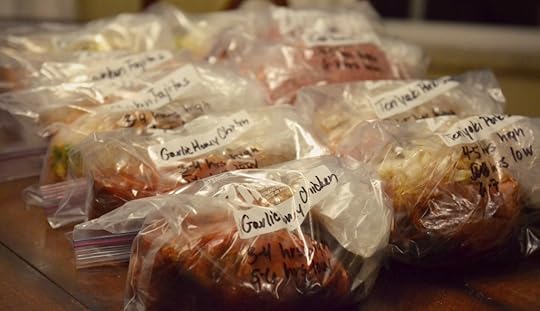
10 Meals in an Hour Series:
Easy Freezer Cooking Meal Plan
10 Meals in an Hour Part 2
10 Meals in an Hour Part 3
10 Meals in an Hour Part 4
10 Meals in an Hour Part 5
10 Meals in an Hour Part 6
10 Meals in an Hour Part 7
10 Meals in an Hour Part 8
* * *
Let me know your family’s favorite make-ahead meals! Do you have any go-to secrets for cutting time off on your meal preparation? What do you find stores and freezes well? Leave a comment below–I’d love to hear your tips!
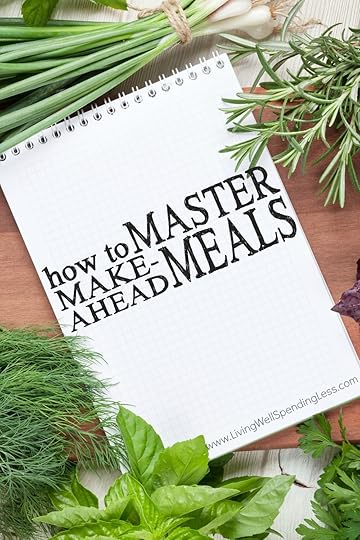
Pin It
The post How to Master Make-Ahead Meals appeared first on Living Well Spending Less®.



